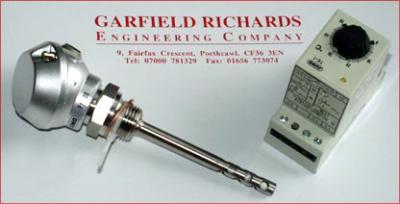Method of Control and Applications GTE, GRE & GTFE Modules only
The fan assisted flue induces a constant air movement through the burner bars. With a constantly lit ignition pilot, monitored by ionisation probe, the main flame can be switched on and off rapidly. No pre or post purge is necessary and the units frequency of switching is dictated by the control system.


The control includes a duct sensor in the leaving air stream, some 1 to 2 meters from the heat exchanger. This Resistance Thermometer, PT100 type sensor, is a resistive device with a resistance that varies with temperature. The sensitivity of the standard device is plus/minus 1°C with a 1 second response time. The duct sensor is connected to a controller by up to 100m of shielded 0.75mm cable. The controller amplifies the resistance and passes it to a comparator. A difference is detected which is used to trigger a switch with a variable set point which relates to a leaving air temperature set point on the adjustable potentiometer. This trigger is used to operate an integral relay which positively switches the gas burner on and off.
The system offered by GRE is a closed loop system and is supplied as a package for use as local control. The gas operating valve is suitable for frequent switching operations,and can be used with Building Energy Management systems which gives complete control of leaving air temperature through the BMS facilities. The systems control company you select will be able to advise on their equipment.
Examples of applications
- Air Handling unit used to heat room with fresh air input.
The room thermostat can be fitted into the control circuit of the module, switching continuous operation off. With the duct sensor set at 1 or 2 degrees above the room temperature, the unit will pulse the burner to maintain the temperature, balancing the losses without increasing the sensible space temperature and eliminating the cold air input associated with a simple on/off control room thermostat.
- Air Handling unit used to make up extraction air, tempered makeup air unit.
The unit operates when the extraction system is on with the Pulse controller maintaining the off air temperature by switching the main flame on and off cyclically to +/- 2°C.
Controller Operation
The probe signal is amplified and passed to the comparator, here the difference is formed by the process and the setpoint selected on the setpoint knob, producing the control deviation.
The difference produced during a control deviation operates the trigger stage through an i.c. amplifier. The trigger output operates the relay with one floating closing contact. A signal lamp LED lights up when the relay is energised.
The controller is fitted as standard with probe failure and probe short circuit protection, and is din rail mountable 35mm wide 70mm high 80mm deep over set point knob on front.
